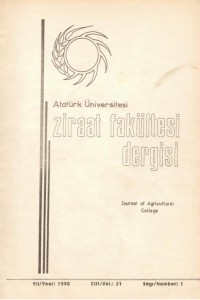RÜZGAR HIZI VE YÖNÜ İLE HAVA ÇIKIŞ AÇIKLIĞI TİPİNİN HAVALANDIRMAYA OLAN ETKİStNÎN KAPALI SIĞIR BARINAĞI MODELİNDE İNCELENMESİ ÜZERİNE BİR ARAŞTIRMA
Öz
ÖZET
Bu araştırma, 30 başlık kapalı ve duraklı süt sığırı ahırının 1/20 ölçekli
modeli üzerinde yapılmıştır. Rüzgar hızı ve yönü ile farklı 4 tipte planlanan mahya hava
çıkış açıklıklarının model içi hava dağılımına ve havalandırma miktarına olan etkisi
araştırılmıştır. Araştırma laboratuvar koşullarında yapılmış olup rüzgar tünelinden sağlanan
değişik yönlerden esen farklı rüzgar hızları ile mahya hava akım hızlan ve model içi ve dışı
arasındaki sıcaklık farklarıyla olan ilişkileri belirlenmiştir.
Araştırmadan elde edilen sonuçlara göre, mahya açıklığının şekli, rüzgar yönü ve
yapının konumu mahya hava akım hızını önemli ölçüde etkilemektedir. Dikdörtgen orifıs
şeklinde planlanan mahya açıklık tipi, diğer tiplere oranla daha uygun havalandırma
sağlamaktadır.
RIDGE VENT, WIND DIREKTION AND WIND VELOCITY EFFECTS
ON CLOSED, NATURALLY VENTTLATED, CATTLE BUILDlNG VENTILATION
SUMMARY
Naturally ventilated buildings used for cattle production hava
various ridge vent configurations. Information pertaining to the ventilation characteristics
ofdifferent geometrically shaped ridge vent is limited. Therefore, the effects ofwind speed,
wind direction and ridge vent shape were studied in a model (1/20 scale) on ventilation
characteristics, naturally ventilated, dairy cattle building. A simple wind tunnel was built to
develop an airflow pattern. Wind was simulated by variable speedfans. Wind speed varied
between 0 to 7 mJs.
The construction of the model was based on a geometric lenght scale of 20, and the
assumption was t hat the samefluid and material would be used in the model and prototype, Trusses, purlins, poles, sides and roof were made of wood. The end walls were
constructed with plexiglass for the purpose ofvisual observation of airflow patterns. The
four ridge vents were constructed by using galvanized metal.
Principles of similitude and dimensional analysis were utilized in deriving a set of
independent and dependent Pi terms, From the defination of the Buckingham Pi Theorem a
set of14 dimensionless Pi terms were obtained (Langhaar, 1983).
The sdudy descr 'ıbed in this paper was conducted to determine which type of ridge
vent would be suitable for naturally ventilated dairy barns in cold regions. Resuîts indicated
that ridge vent design has a signifıcant effect on outled velocity and wind velocity.
Temperature difference was affected by ridge vent geometry and vind velocity.
The baffled (Type II) ridge vent had the highest outlet velocity when ali wind
directions were considered, while covered (Type III) ridge vend produced the lowest outlet
velodties.
AUhough the covered ridge vent produced the largest temperature differences, the
associated low outlet velodties make it the least desirable of the four ridge vents tested.
Anahtar Kelimeler
Ayrıntılar
| Birincil Dil | tr; en |
|---|---|
| Bölüm | ARAŞTIRMALAR |
| Yazarlar | |
| Yayımlanma Tarihi | 2 Ocak 2011 |
| Yayımlandığı Sayı | Yıl 1990 Cilt: 21 Sayı: 1 |
Kaynak Göster
Bu dergide yayınlanan makaleler Creative Commons Uluslararası Lisansı (https://creativecommons.org/licenses/by-nc/4.0/) kapsamında yayınlanmaktadır. Bu, orijinal makaleye uygun şekilde atıf yapılması şartıyla, eserin herhangi bir ortam veya formatta kopyalanmasını ve dağıtılmasını sağlar. Ancak, eserler ticari amaçlar için kullanılamaz.
https://creativecommons.org/licenses/by-nc/4.0/


